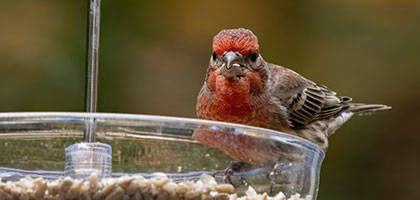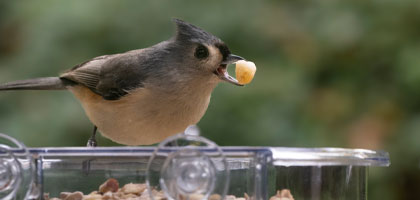When it comes to attracting sparrows to your garden, choosing the right bird feeder can make all the difference. Sparrows are one of the most common birds found in urban and rural areas, and they bring a delightful presence to any backyard. But with so many bird feeders available, how do you know which one is best suited for sparrows? In this guide, we'll explore different types of bird feeders, what makes them ideal for sparrows, and how you can create a welcoming environment for these charming birds.
Understanding Sparrows and Their Feeding Habits
Before diving into specific feeders, it's essential to understand the feeding habits of sparrows. Sparrows are primarily ground-feeders, meaning they naturally forage for food on the ground. They have a preference for seeds, grains, and occasionally insects. Knowing this can help you select a feeder that matches their natural feeding behavior.
Key Characteristics of Sparrows
Diet Preferences
Sparrows enjoy a diet mainly composed of seeds like millet, cracked corn, and sunflower seeds. These seeds are not only nutritious but also small enough for sparrows to consume easily. Insects play a minor role in their diet, typically during the breeding season when protein is crucial for chick development. Understanding their diet helps in selecting the right mix of seeds to attract and nourish them.
Social Behavior of Sparrows
These birds are social creatures and often feed in groups. This social feeding behavior means that feeders should ideally accommodate multiple sparrows at once. Observing sparrows as they communicate and interact at feeders can be a delightful experience, showcasing their complex social structures and hierarchies.
Habitat Adaptability
Sparrows are highly adaptable birds that can thrive in various environments, from city parks to rural farmlands. This adaptability makes them resilient and successful in different landscapes. They are equally comfortable in human-altered environments, making urban gardens a perfect spot for them.
Feeding Patterns
Sparrows tend to feed most actively during the early morning and late afternoon. This pattern is crucial to consider when planning the timing of feeder refills. Understanding their feeding times can help you maintain a consistent food supply, ensuring that sparrows visit your feeder regularly.
Ground-Feeding Tendencies
Being ground feeders, sparrows naturally forage for food on the ground. This behavior is essential when choosing feeders that mimic their natural feeding habits. Ground-level feeders or scattered seeds can effectively attract sparrows by aligning with their instinctual behaviors.
Types of Bird Feeders Suitable for Sparrows
There are several types of bird feeders available, each with its own set of advantages. Here's a breakdown of the most popular options for sparrows:
Hopper Feeders
Hopper feeders are an excellent choice for sparrows due to their design. These feeders have a container that holds the seed and a tray at the bottom where the seed is dispensed. The seeds are protected from the weather, and the feeder can hold a substantial amount of bird seed, making it ideal for sparrows that feed in groups.
Design Benefits
Hopper feeders protect seeds from rain and snow, ensuring that they remain dry and fresh. This design also allows for a large capacity of seed storage, reducing the frequency of refills. Such advantages make hopper feeders a convenient option for busy bird enthusiasts.
Drawbacks to Consider
While hopper feeders are practical, they can be more challenging to clean. The intricate design may accumulate debris and require thorough maintenance. Additionally, their larger size might attract bigger birds that could outcompete sparrows for food.
Ideal Placement
Positioning hopper feeders in sheltered areas can enhance their effectiveness. Placing them near shrubs or trees offers protection and encourages sparrows to visit. This strategic placement helps in mimicking the natural environment sparrows prefer.
Platform Feeders
Platform feeders are open trays that can be mounted on poles or placed directly on the ground. These are particularly suitable for sparrows because they mimic their natural ground-feeding behavior. Platform feeders allow multiple sparrows to feed simultaneously and can be filled with a variety of seeds.
Advantages of Platform Feeders
Platform feeders provide easy access for sparrows, allowing them to feed comfortably. The open design supports social feeding, accommodating several birds at once. This setup is perfect for observing sparrows' interactions and dynamics.
Challenges of Using Platform Feeders
One significant drawback is that platform feeders expose seeds to weather elements. Rain or snow can lead to soggy seeds, encouraging mold growth. Regular cleaning is necessary to maintain hygiene and prevent disease spread among birds.
Enhancing Platform Feeder Use
To maximize the benefits of platform feeders, consider using weather-proof covers. These covers can shield seeds from rain while still providing open access. Additionally, placing platform feeders in areas with natural cover, like under trees, can offer protection from elements.
Tube Feeders
Tube feeders consist of a hollow cylinder with multiple feeding ports. They are designed to accommodate smaller birds like sparrows, as larger birds may have difficulty accessing the feeding ports. These feeders are perfect for keeping the seeds dry and are easy to maintain.
Unique Features of Tube Feeders
The cylindrical design of tube feeders ensures seeds remain dry, as they are stored inside the tube. The multiple ports cater specifically to small birds, making it a sparrow-friendly option. The vertical structure can save space in compact gardens.
Potential Limitations
One limitation is the restricted space for multiple sparrows. Unlike platform feeders, tube feeders cater to individual feeding. This limitation might reduce the number of sparrows visiting at one time, impacting the social feeding experience.
Placement Tips
Positioning tube feeders at varying heights can attract a diverse range of small birds, including sparrows. Hanging them from tree branches or garden hooks provides a stable and safe feeding environment. Elevating tube feeders can also deter ground predators.
Ground Feeders
While not technically a feeder, scattering seeds directly on the ground is an effective way to attract sparrows. This method aligns with their natural feeding habits and allows them to forage comfortably.
Benefits of Ground Feeding
Ground feeding is the most natural method, enticing sparrows with an instinctual feeding approach. This method eliminates the need for additional feeder equipment and can be an economical choice for bird enthusiasts.
Drawbacks of Ground Feeding
The primary disadvantage is the exposure of seeds to weather conditions. Rain can spoil seeds, and pests like rodents might also be attracted. Frequent replenishment is necessary, particularly after adverse weather events.
Enhancing Ground Feeding
To enhance ground feeding, consider using trays or shallow dishes to contain seeds. This approach can minimize seed loss and contamination. Additionally, regularly rotating feeding areas can prevent soil compaction and overuse.
Selecting the Right Bird Seed for Sparrows
Choosing the right type of seed is as important as selecting the right feeder. Sparrows are not picky eaters, but they do have preferences:
White Millet
A favorite among sparrows, white millet is small and easy for them to consume. This seed type is highly nutritious and readily available, making it a staple choice for sparrow feeders. Its small size ensures ease of handling by sparrows, promoting frequent feeding.
Cracked Corn
Cracked corn provides an energy-rich option for sparrows, especially in colder months. Its high-calorie content supports the increased energy demands during winter. However, it should be offered in moderation, as excessive amounts can attract larger, less desirable bird species.
Sunflower Seeds
While sparrows enjoy sunflower seeds, opting for hulled sunflower seeds prevents the mess of shells. Hulled seeds are easier for sparrows to eat and reduce waste accumulation beneath feeders. Mixing them with other seeds can create a balanced and appealing feed blend.
Creating a Seed Mix
Mixing these seeds can create an irresistible blend for sparrows, encouraging them to frequent your feeder. A well-balanced mix caters to their dietary needs, ensuring a steady supply of nutrition. Experimenting with different seed ratios can help identify the most attractive mix for local sparrows.
Tips for Maintaining Your Bird Feeder
Regular maintenance of your bird feeder is crucial to ensure the health and safety of sparrows:
Clean Regularly
Remove old seed and debris to prevent mold and disease. Regular cleaning minimizes health risks and keeps the feeding area hygienic. A clean feeder is more attractive to sparrows, encouraging consistent visits.
Check for Damage
Inspect your feeder for any damage or sharp edges that could harm birds. Regular inspections ensure the feeder's integrity and prevent injury to visiting sparrows. Addressing wear and tear promptly can prolong the feeder's lifespan.
Refill Often
Keep the feeder stocked, especially during high-traffic times like early morning and late afternoon. Consistent refilling ensures sparrows have a reliable food source, promoting regular visitation. Monitoring feeding patterns can guide optimal refill schedules.
Seasonal Adjustments
Adjust feeder types and seed mixes according to seasonal changes. Sparrows' dietary needs may vary with changing temperatures and food availability. Adapting your feeding strategy ensures you meet their nutritional requirements year-round.
Creating a Sparrow-Friendly Environment
Beyond feeders, creating an inviting environment will encourage sparrows to visit your garden:
Provide Shelter
Plant shrubs or install a birdhouse to offer protection from predators and harsh weather. Dense vegetation provides cover and nesting opportunities, enhancing the habitat's appeal. A well-sheltered garden can become a safe haven for sparrows.
Water Source
A birdbath or shallow water dish can attract sparrows looking for a drink. Clean, accessible water sources are crucial, especially during dry spells. Regular cleaning ensures water remains fresh and appealing.
Avoid Pesticides
Use natural alternatives to keep your garden healthy and safe for sparrows. Chemical pesticides can harm both sparrows and the insects they feed on. Embracing eco-friendly gardening practices promotes a healthy ecosystem for all wildlife.
Native Planting
Incorporate native plants that provide natural food sources and habitat. Native flora supports local insect populations, offering additional food for sparrows. A diverse plant palette can enhance biodiversity and ecosystem health.
Conclusion
Selecting the best bird feeder for sparrows involves understanding their natural feeding habits and choosing a feeder that accommodates their preferences. Whether you opt for a hopper, platform, tube, or ground feeding method, providing the right environment and maintaining your feeder will ensure your garden becomes a favorite spot for these delightful birds. By investing in the right feeder and seed, you can enjoy the lively presence of sparrows all year round. Engaging with these charming birds not only enriches your garden but also supports local biodiversity and ecological balance.






